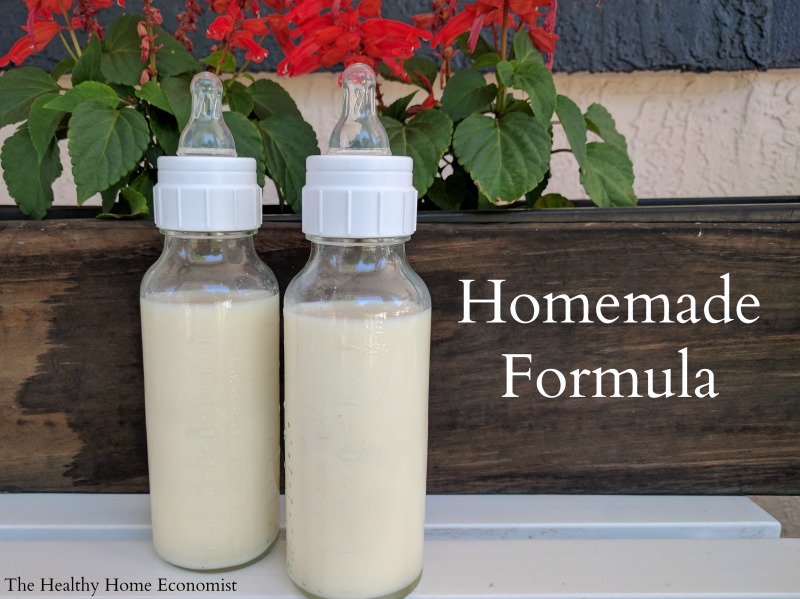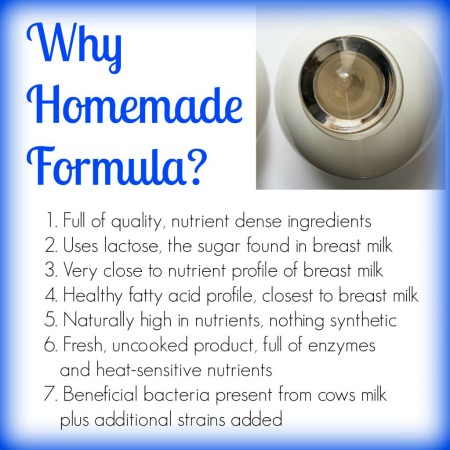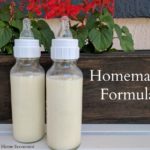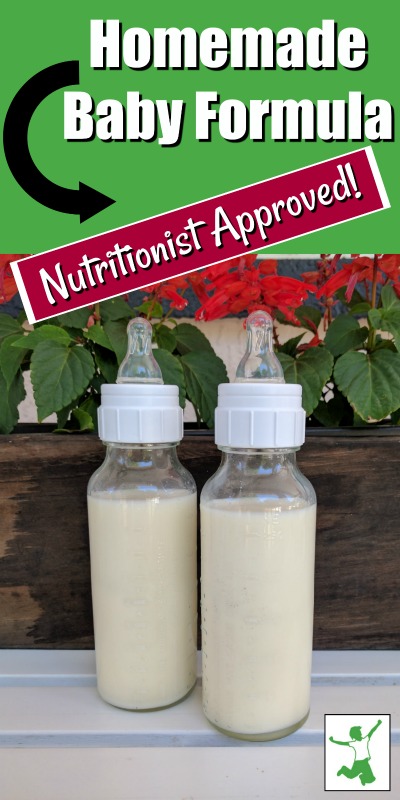Table of Contents[Hide][Show]
A nourishing homemade baby formula using safe, whole ingredients. This recipe was developed and tested by Dr. Mary Enig, a PhD Nutritionist and originally published in Nourishing Traditions cookbook in 1996. It was formulated to match breastmilk as closely as possible and is also suitable for infants. Source: Weston A. Price Foundation

There is no doubt that breastfeeding your baby is the best option for the child’s long-term health and development. Human breastmilk from a well-nourished mother is the perfect food for baby. However, in circumstances where the child is adopted or the Mother finds herself unable to breastfeed, formula feeding becomes necessary. In those cases, homemade baby formula is best.
Using a baby formula recipe that closely matches the nutritional profile of breastmilk is a far better choice than even organic baby formula from the health food store. More on this below.
Note: Donor programs are widely available for human breastmilk. But, the diets of the donor mothers are unknown and most likely nutritionally insufficient. In addition, breastmilk banks pasteurize the donated breastmilk which destroys much of the nutritional benefit. Unless you are fortunate to have a trusted and direct donor milk source in your community, avoid this option!
Dangers of Commercial Formula
Commercial formulas are always a poor choice for a number of reasons. First of all, formula manufacturers line the cans with the chemical BPA. This substance disrupts hormone development and is a probable contributor to early puberty in girls, and ADHD, urogenital abnormalities, and other ills in boys.
The European Food Safety Authority found that canned commercial formula is a significant source of BPA for infants, exposing the child to 13mcg of BPA per kg of body weight per day! BPA-free formula cans are no better. The chemical BPS is typically used instead which is just as dangerous.
Beware that manufacturers pack even organic commercial formula like Earth’s Best in BPA cans. Worse, they use organic brown rice syrup as the primary sweetener which is known to be frequently contaminated with arsenic.
In addition, all commercial milk formulas are processed at extremely high temperatures which violently denature the fragile milk proteins, render them allergenic, and add carcinogens to the final product. Soy infant formula is the worst. Obscenely high processing temperatures not only denature the proteins but large levels of phytic acid in soy block mineral absorption by the infant. Moreover, soy-based plant estrogens disrupt the hormonal development of the baby!
It seems that for the concerned Mother who is unable to breastfeed, learning how to make baby formula at home with safe, pure ingredients is the most prudent way to go!
Why Make Homemade Formula Even if You Are Breastfeeding
In the video below, I show you how to make your own safe, healthy raw milk homemade formula for your baby.
The recipe I follow was originally published in the cookbook Nourishing Traditions in 1996 and developed by Dr. Mary Enig.
Even though I breastfed each of my children for at least 2 years, I made this exact formula for my own children when I was away for the day or the evening as pumping was not an option that worked well for me.
I even used this homemade formula for an entire day once when I had some dental work done and was advised to pump and discard for 24 hours.
As a result, even successfully breastfeeding Moms can use this wonderful homemade formula as a supplement when necessary to their own nutrient-dense breastmilk!
It is advised that even breastfeeding Mothers have the ingredients for this formula on hand for an emergency. If Mom is sick or otherwise unable to nurse, Dad can step in and make this safe alternative until Mom is back on her feet. It takes a few days to a week to gather all the ingredients together to make this formula, which is why I advise having them on hand at all times.
Homemade Most Nutritious
The image below lists the reasons why it is worth it nutritionally to make formula yourself for your precious baby!
You can order all of the required ingredients for the homemade baby formula in one package from this reputable, vetted source.
Moms who have successfully used this formula feeding your children, please post about your experience in the comments section to encourage those who are considering it and need some Mom to Mom encouragement!

Where to Source Quality Milk
The most widely available grass-fed milk around the world is from cows. This is usually the most budget-friendly and easily sourced milk for this recipe for homemade formula.
If only goat milk is available in your area, this recipe for goat milk baby formula can be used instead. When using milk from ewes, please refer to the linked article for an adjusted recipe; one of the benefits of sheep milk is that it is higher in healthy fats than either goat or cow milk.
Camel milk formula is another option that is a particularly digestible form of dairy and growing in popularity around the world.
Alternatively, you can use low temp (vat) pasteurized, non-homogenized whole milk cultured with a piima or kefir starter. Then substitute the piima milk or kefir for the raw milk portion of the formula recipe. Cold-pressed raw milk also must be cultured before using it as it contains no probiotics.
Do NOT use ultrapasteurized (UHT) milk even if organic as it is too highly processed and extremely allergenic!
It is also best to avoid all types of powdered milk for this recipe. The factory process of making milk powder reduces nutrition considerably and denatures it, which makes it more likely baby will have an allergic reaction.
Dairy Allergy Option
If all types of dairy prove unsuitable for your baby, make this nondairy baby formula recipe instead. It uses a base of homemade bone broth as a substitute for milk. It is important not to utilize a plant-based or otherwise vegan baby formula recipe.
Avoid buying bone broth to make the dairy-free formula. Make it yourself! Manufacturers of commercial bone broth, even if authentic, may water down the end product. This is apparent if it does not gel when chilled in the refrigerator.
Many brands have toxic packaging issues as well. If you must buy it in a pinch, see my shopping guide page for vetted brands that are safe.

Homemade Baby Formula Recipe (for infants too)
A nourishing baby formula recipe you can make at home with safe, whole ingredients developed and tested by a PhD nutritionist to match breastmilk as closely as possible. Also suitable for infants.
Ingredients
- 2 cups raw cow milk OR organic whole milk yogurt
- 1 7/8 cups filtered water
- 1/4 cup liquid whey
- 4 Tbl lactose
- 1/4 tsp Bifidobacterium infantis powder
- 2-4 Tbl raw or pasteurized cream
- 1/2 tsp cod liver oil unflavored
- 1/4 tsp butter oil unflavored
- 1 tsp sunflower oil preferably organic
- 1 tsp extra virgin olive oil preferably organic
- 2 tsp virgin coconut oil preferably organic
- 2 tsp nutritional yeast
- 2 tsp gelatin
- 1/4 tsp acerola powder
Instructions
-
Fill a 2 cup Pyrex measuring cup with filtered water and remove 2 TBL (this will give you 1 7/8 cup water).
-
Pour about half the water into a pan and turn burner on medium.
-
Add the gelatin and lactose and let dissolve, stirring occasionally.
-
When gelatin and lactose are dissolved, remove pan from heat and add the rest of the water to cool.
-
Stir in the coconut oil and butter oil until melted.
-
Put remaining ingredients in a glass blender.
-
Add the water mixture and blend for about 3 seconds.
-
Place formula in glass baby bottles or a glass jar and refrigerate.
-
Before giving to baby, warm glass bottle in a pan of hot water or a bottle warmer. NEVER microwave baby bottles!
Recipe Video
Recipe Notes
If using raw cow milk from holstein cows, use 4 Tbl of extra cream (otherwise use 2 Tbl extra cream).
If choosing to make this homemade formula with camel milk, be sure to include 4 Tbl extra cream as camel milk is lower in cream than cow milk.
Do not use high oleic sunflower oil. Use only the brand recommended in the ingredients list which is cold pressed, organic, unrefined, and low oleic.
*Do NOT use powdered whey from the store as it is denatured. Avoid whey from making cheese as it will curdle the formula.
*Do not substitute pasteurized or powdered milk as these are heavily processed, denatured and allergenic foods.
*Do NOT use ultrapasteurized (UHT) cream. It is highly allergenic. Raw or pasteurized cream is acceptable.
*Do NOT use fish oil or krill oil instead of high vitamin cod liver oil as they do not contain any Vitamin D and very little to no Vitamin A.
Collagen powder may be substituted for the gelatin in a pinch (more on peptides in baby formula in this article).
If you are wondering where is the iron in homemade baby formula, this article provides an explanation.
If baby experiences constipation using this formula, try adding 1 tsp of molasses to each batch. This should help move things along.
How to Transition to DIY Formula
Once you’ve viewed the video, gathered the ingredients, and made your first batch, how do you feed it to your baby for the first time?
It is important not to switch all at once as this can cause gas, excessive spit-up, or an uncomfortable change in diaper habits such as constipation or overly loose stools.
Start by giving your baby three-quarters of the old formula blended with one-quarter of the homemade. Try this ratio for a day or two and see how your infant responds.
If no digestive upset or major change in diaper habits occurs, increase the amount to a 50-50 blend of old formula to homemade. Observe for another day or two as before.
If no major issues, increase once again to three-quarters homemade formula to one-quarter old formula. If baby does well on this blend for a third time, you are ready to fully transition to the homemade formula.
At any time during the transition, symptoms of intolerance emerge, back up to the previous successful blend ratio and stay there for a day or two before attempting to increase once again.
Homemade Formula FAQ
Weston Price Foundation
Feeding an Adopted Baby
Traveling Tips with Baby Formula Made at Home
Iron in Baby Formula
Collagen Peptides instead of Gelatin for Homemade Formula?










I’ve been making the formula for almost 3 months now. All of the sudden it is smelling like rotten eggs after the bottle is being warmed. Could one of my ingredients be bad? Also how do you suggest gradually weaning to raw milk, once the baby is a year?
Check the packaging of the other ingredients like nutritional yeast and see if they have expired.
To wean off the formula onto plain raw milk, gradually reduce the amount of formula in each cup used. I would suggest (you can do it more slowly if you like) 3/4 formula to 1/4 plain raw milk the first week, the second week half and half, the third week 3/4 raw milk and 1/4 formula, and finally the fourth week all raw milk. I know a few mothers who did it this way and it worked very well.
For the probiotic I see the recommendation is Natren , what if I use udos choice infant probiotic? The strains are more strains in the later. I am trying to make the formula for my 3 week old son. I had used udos choice in her homemade formula for my daughter from she was a 9 month old till a year.
How long do you recommend feeding this homemade recipe? My baby is 11 months, and on BM 3x a day and formula (commercial! no more!) 1x, but he’s almost a year… should we gradually switch to plain raw milk, or should I make this formula?
Use this formula until he turns 1 then gradually switch to whole raw, grassfed milk. If he isn’t eating much in the way of solids yet, you might wish to extend it a bit until he’s eating more.
Can someone tell me how much this recipe makes & how long it can store in the refrigerator?
The recipe lists that one batch is 36 ounces. Also in the post is that it should be refrigerated only 1-2 days before making another fresh batch. You can freeze some for emergencies if you like.
I have a three and a half week old baby and I have had to supplement him since birth. We have used commercial formula but he is having super painful gas and such with it, even the “hypoallergenic” kind. I have been searching for non commercial alternatives and found this site and recipe.. I have access to raw goats milk or raw cows milk in my area but I really don’t know much about drinking either for myself or using in a recipe like this.. do I need to worry about bacteria or anything like that with giving the raw milk to my baby? I know you can get sick from raw milk if it isn’t handled correctly from cow to table, is that correct? Does this recipe process sort of pasteurize the milk when the hot ingredients aren’t added to the the rest of the ingredients in the blender? I just want to make sure I understand so that I don’t accidentally make my baby very sick or anything!
So I have been using this formula recipe exclusively (my breastmilk was not producing enough nutrients and fat to help my newborn grow) for the last month or so. My little one is 2 months old. When I first started to give this formula to my daughter I had already been giving her Organic store brand formula since she was 4 days old up to 4 weeks. Because of the organic powder formula, which with my other two I had problems with, she had a hard time passing a bowel and was constipated. There were numerous of times she wouldn’t go for a day or even two days. Which is a lot considering I started using this homemade recipe at 4 weeks.When I had all the ingredients I started cold turkey since I really wanted to get her off of the organic store bought formula and replace it with something nutritionally dense. Because I didn’t adjust her to the new formula she was constipated and fussy for two days but I made sure to gently massage her belly and do bicycles with her legs (at this point I was already used to it because of the store bought formula). Once that was over with she was having regular bowels, between 2-3 per day. My pediatrician emphasized that he would really like to see the ideal BM which is 3 and at that time I had just started giving her the homemade formula and was not having regular bowel movements.
My daughter is doing so good on the formula she doesn’t spit up which is very common when giving store-bought formula, at least in my kiddos. She was born at 7lbs 4 oz and at her 1 month checkup she was 9lbs 5oz ( which I literally had just started putting her on the homemade formula) then I went back a week later to make sure she as gaining weight and she was 10lbs. My ped said she was doing good and I told him that she now had 3 bm per day he said she was doing really well and that she looked and sounded healthy! I have a checkup soon but she has definitley gained weight and is almost fits in 3 month clothes. She is super alert and development is on track! At first I was afraid to try this since my mind was thinking I am not sure if anyone has ever tried this exclusively from around birth but after seeing her development on track and my pediatricians confirmation of her good health my doubts have gone. I wish I could have kept just supplementing along with my breast milk but after the third time of mastitis my milk supply had practically diminished and the pump was not stimulating enough and my daughter refused to latch to the breast. 🙁 But I feel confident that I am giving her the next best thing! If your thinking of trying homemade formula and maybe have doubts or fears just try it, I did and my child is thriving. I love that I am giving her a whole food and something that is not overly processed. I also love that she is gaining weight not with Hight fructose corn syrup or other syrups but because of good healthy fats. It doesn’t hurt to try it and if something seems like its not sitting right with baby after that first week maybe try adjusting something. I know the “benefits” of regular formula from my first two kiddos and I know that health wise this time around will be much more different because I am giving her something nutritionally dense. I will try to remember to post again at 6 months!
This is true! Whenever you change formula it does have to be gradual I have been using this formula for a month now and when I first started my little one didn’t have a bowel for almost two days as well…but now she is a regular pooper 🙂 she has at least 3 bowel movements per day which is more than when I had her on regular formula! But since this is my third little one I informed about this from my pediatrician when I had to switch formulas with my first born.
Oh yes, I see them now. Only showing 5 or 6 originally. I’ll give it a look.
PS. I did make the formula using raw milk and baby was backed up for 2 days. Very traumatic on baby and mom. Needless to say, my daughter isn’t willing to try again with goats milk. The pediatrician wasn’t very happy and discouraged her from making any homemade formulas again. While I’m disappointed in the outcome I hope that she will change her mind in the future.
You can’t switch to homemade formula suddenly. Like with any change in formula, it must be gradual to give baby time to adjust!
Hi Sarah,
I love all the information in this video and am excited to give this a try. My daughter (who is the one with the baby) is hesitant to go with a homemade version and would like to hear from someone who does this regularly and can vouch for the efficacy and benefits over store bought formula. I am well aware of them…just having a hard time convincing my daughter. Do you have more testimonials? Thank you for posting this video and making it easy to follow with step by step instructions.
Have you read through the comments? There are a number of testimonials there from what I recall. I realize there are hundreds of them, but you should be able to find what you need there 🙂
Why did the milk turn out jelly like? What did I do wrong ? Please help
It’s just the gelatin. When you warm the formula for a bottle, everything will liquefy.